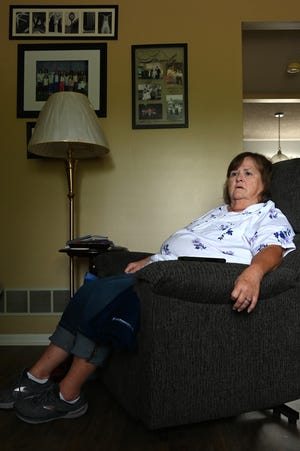
Deborah Wood spent her 69th birthday two weeks ago alone in her quiet Fairfield home, wincing through the stabbing pains in her stomach, lungs and heart. For the last year and a half, she’s spent most of her nights like this.
This is how COVID-19 has left her.
She says that her March 2020 diagnosis felt like a death sentence. Especially since she was the first COVID patient at Mercy Health-Fairfield Hospital and third in Butler County, according to Mercy Health spokesperson Nanette Bentley.
Wood survived a two-week hospitalization and a round of Hydroxychloroquine, an immunosuppressive drug touted by then-President Trump and since shown to have no antiviral effects on COVID-19.But her life, body and mind were forever changed.

The condition is called Long COVID. She is now among many now referred to a "long-haulers."
They are in a position that many doctors didn’t expect to even exist.
In 40 years of medicine, TriHealth pulmonologist David Wiltse said he’s never seen a condition cut across the body and leaves destruction in its wake quite like Long COVID.
And in such large numbers.
A report published in the journal A FAIR Health White Paper said that about a quarter of COVID survivors develop Long COVID. This leaves over 3 million Americans with the condition. And about a third of these patients report never even feeling sick when they had the active virus, according to a study published in the journal MedRXIV.
"They can’t go back to work," explained Wiltse. "It disrupts their relationships with their families. This is like having a brain injury that is haunting you for months or years thereafter."
With almost 4 million COVID-related deaths worldwide, Wiltse insists that the virus has still not made its point. “That’s the real story of COVID, the tragedy that is going to haunt us for years.”
Living proof
Like many other long-haulers, most of Woods’ symptoms are mysterious, often undetectable on tests and difficult to treat. The symptoms are real. But there’s not much they can do.
According to Dr. Kevin Hartman, Wood’s primary caregiver at Mercy Health, she has typical Long COVID symptoms.
And her symptoms are plenty.
She said her first sign of the virus back in February 2020 was the loss of taste and smell. She’s gotten them back. Then lost them again. Then they returned. And she lost them again.
When she first contracted the virus, Wood started having headaches. They never went away. Even now, she points to her right eye with a squint.
“It’s like you can pinpoint exactly where the stupid thing is,” Wood says. “But you can never make it go away.”
Wood says her hair started to fall out in May 2020. She would catch clumps of her pin-straight locks falling out in the shower, brushing her hair. Anywhere. Everywhere. Now grown back, it's curly and unfamiliar.
She says she has around-the-clock brain fog that her family calls “COVID brain.” It started in the hospital. She still has it. She says she forget things even as they come out of her mouth.
When she first got sick, she says her body felt like it was on fire. She still has bodily pain. But it’s different now. She says she now has a random string of stabbing pains that begin in her stomach and travel to her heart and lungs.
Wood’s most pervasive issue is fatigue. She says it’s been with her now for almost 18 months, since she first got sick.
Returned to real life, the tiredness takes a daily toll. After three-hour shifts as a cafeteria cashier at West Elementary School in Fairfield, she says it took all her energy to trudge in the house and plant herself in an armchair. She says she sometimes sleeps there when the staircase to her bedroom seems too daunting.
When the fatigue is at its worst, she says she skips dinner. She just doesn't always have the energy to cook. Or wash the dishes. Or even chew.
She said there are parts of her she’s lost to this COVID-induced malaise. She points to the nearly-finished quilt draped on a chair, a project that’s been waiting final touches for a year now. And the phone. She loves to chat but sometimes she’ll let it keep ringing.
Her family noticed this change early on, when she was first admitted to the hospital. Jason Buckley, the youngest of Wood’s three sons, said he watched his mom steadily lose her gusto and curiosity.
“My mom has got to be all up in your business. She wants to be here. She wants to know everything,” Jason said. “If she’s not asking about everybody in the world, and what they’re doing, then you know she’s pretty sick.”
She has remained so.
Buckley said Wood has a mother's tendency to bottle up what bugs her. But he knows that there are things that she’s lost that she’s too cautious to say.
He said she’d dreamed of a big family vacation in recent years. Between her physical capacity to travel and the “astronomical,” in Wood’s words, medical bills, this is a dream she’s had to give up.
Wood bottles up her medical concerns, too. She said that if she suspects that a new pain or ailment is related to COVID-19, she keeps it to herself.
“This is something I’m gonna live with,” Wood said. “Am I calling the doctor? No. What is he gonna do? The same thing I’m doing. Sitting right here.”
Along with self-diagnosis, she said she’s figured out some self-treatments. Eating red meat flares up the stabbing pain in her stomach. She’s phased that out of her diet. As often as she can, she goes to the gym to take a spin on the stationary bike to build up her endurance. She’s taking the summer off work to recuperate.
She says that these things are helping. But the symptoms never really stop, despite periods of reprieve. She says the fatigue and pain always seem to come flooding back.
“It’s like a game with your brain,” Wood said. “It’s like it’s trying to make you think it’s gone. But here it comes again."
Relentless foe
The American Psychological Association reports that patients are also consistently concerned about their long-term mental health post-COVID.
A study from journal The Lancet Psychiatry shows that about a third of all COVID patients report a mental health issue in the six months following their recovery. This includes anxiety, depression, post-traumatic stress disorder and psychosis.
In a blog for Mercy Health, Hartman concurred. He has kept this in mind when caring for Wood who was having a hard time grappling with the new normal.
Add that to being haunted by the illness remembered.
“When I was in the hospital, I literally could feel the virus crawling in my blood,” Wood said. “It was driving me crazy.”
But the worst of all -- during all of it -- was the isolation.
Wood lived alone through the long 2020-21 quarantine. Her family would drop groceries at her door so she wouldn’t have to leave. She had family that lived less than a mile away but she only saw them on Mother’s Day, her birthday and on Christmas.
Even then, the family celebrated by standing at either end of the driveway.
Wood did join a virtual support group for long-haulers across Ohio. Most of the patients are from Cleveland. She's the only one from Cincinnati.
But the distance doesn't seem to matter. She says she’s attended the group via Zoom every Thursday since its inception on May 6, 2020. (Except for one that she forgot. She blames COVID-brain for that lapse.)
Her doctor is pleased by the Zoom group's effect on her.
“She smiles when she tells me that she was about to help someone else by sharing her symptoms and helping them realize that they’re not necessarily alone,” Hartman says. “There was some camaraderie and reassurance developed through meeting with other people who are experiencing this.”
She tells you this is not about giving advice. She doesn’t like to do that. But she finds solace in sharing her story.
And she likes to know that she isn’t alone.
Source link









